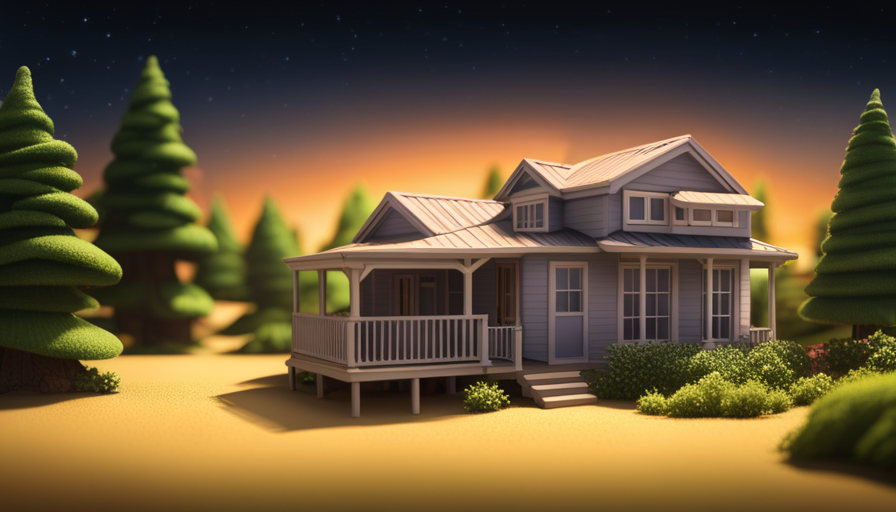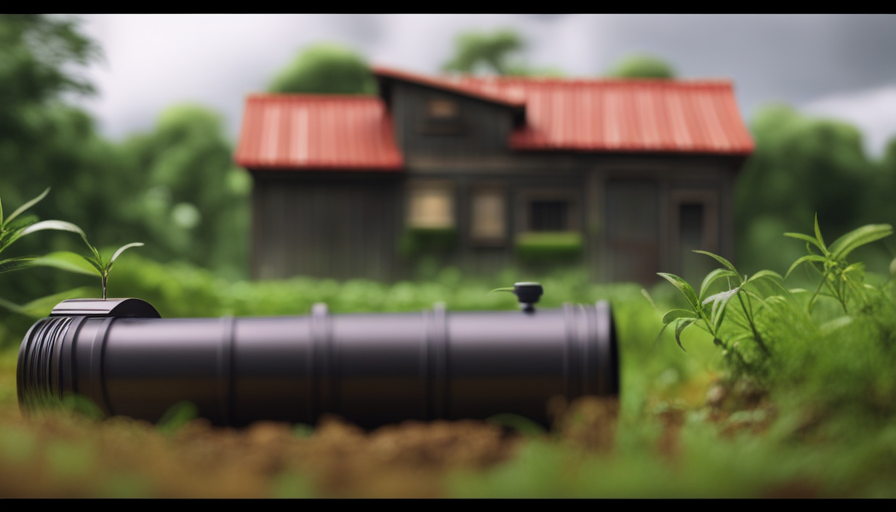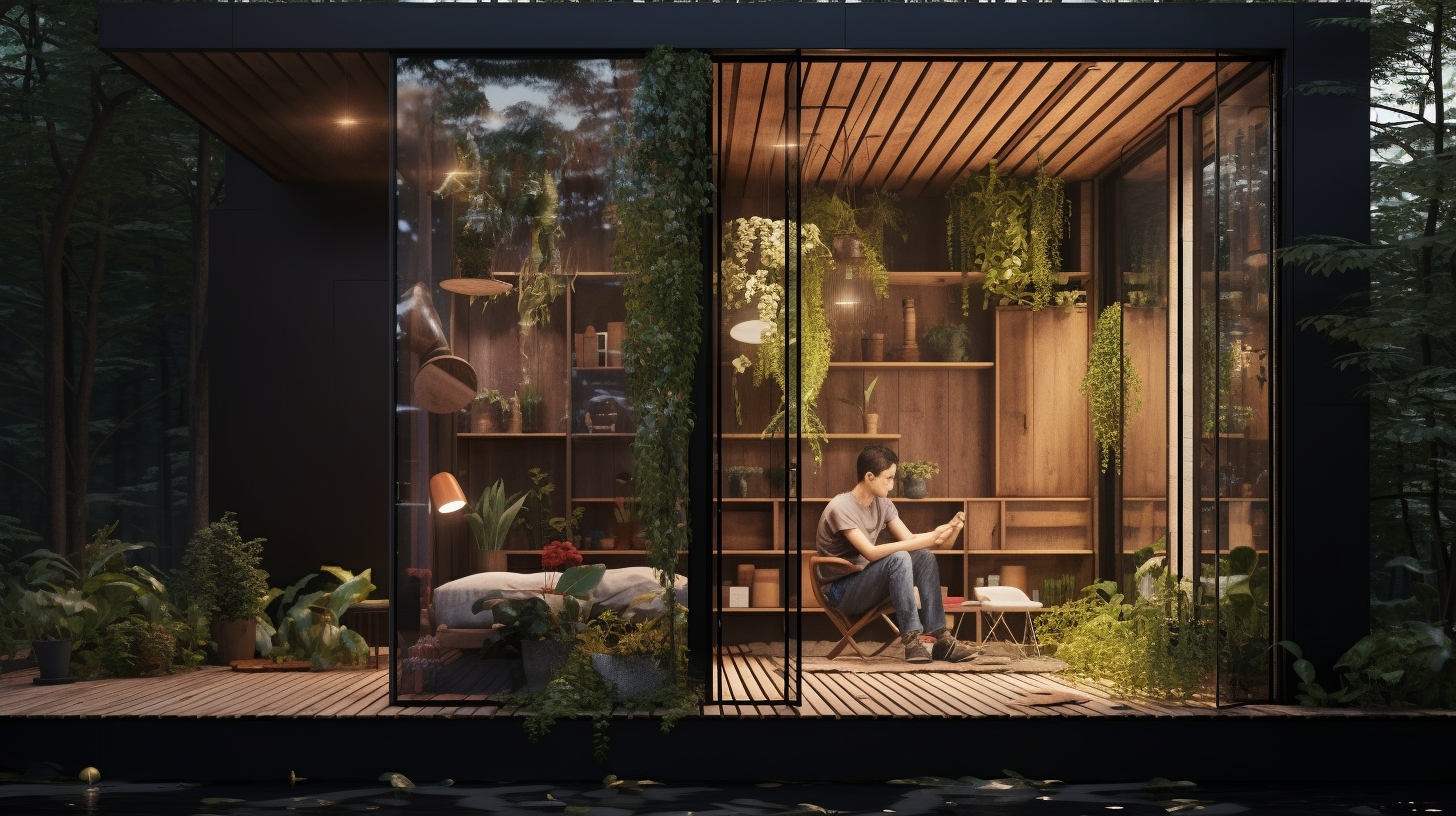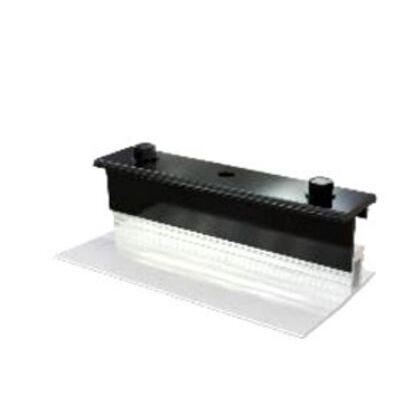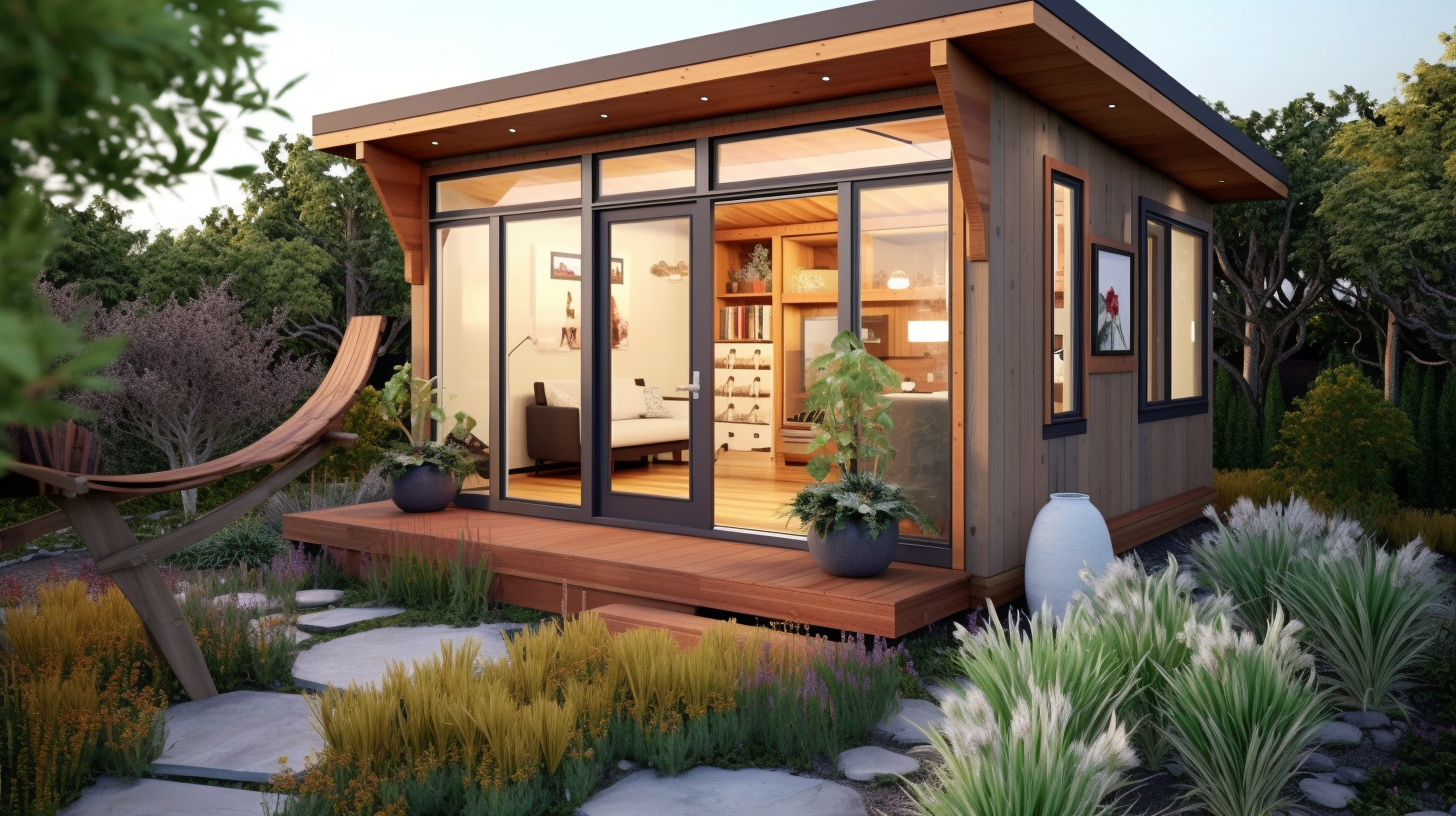Are you thinking about buying a small house? Imagine stepping into a world where simplicity reigns supreme, minimalism is highly valued, and you can fully embrace a minimalist lifestyle. This is a place where you can prioritize comfort without compromising sustainability, reducing your environmental footprint while saving money.
But how do you make this dream a reality? In this article, I will guide you through the process of buying a tiny house, from researching different models to securing financing and arranging for delivery. Whether you’re looking for a cozy retreat in the mountains or a mobile home to explore the open road, I’ve got you covered.
So, let’s dive in and discover how to navigate the world of tiny houses and find the perfect home that fits your needs and budget. Get ready to embark on a journey towards a simpler, more fulfilling life.
Key Takeaways
- Research different tiny house models and compare their size, layout, materials, and customization options.
- Determine your budget and explore financing options such as personal loans, RV loans, or crowdfunding.
- Find a reputable tiny house builder or dealer through research and customer reviews, and visit showrooms and model homes to assess craftsmanship and design.
- Familiarize yourself with zoning regulations and building codes for tiny house placement, and assess the location for accessibility, amenities, and zoning restrictions.
Research Different Tiny House Models
If you’re ready to embark on your tiny house journey, it’s time to start researching and exploring the vast array of unique and innovative tiny house models available. Researching features and comparing prices is an essential step in finding the perfect tiny house that meets your needs and fits your budget.
There are numerous online platforms, blogs, and forums dedicated to tiny house enthusiasts where you can gather valuable information and insights. Take the time to thoroughly research different models, considering factors such as size, layout, materials, and customization options. Look for features that are important to you, whether it’s a loft bedroom, a solar power system, or eco-friendly construction materials.
As you compare prices, keep in mind that the cost of a tiny house can vary greatly depending on its size, design, and location. Once you have a good understanding of the different models available and their price ranges, you can move on to the next step: determining your budget and financing options.
Determine Your Budget and Financing Options
Once you’ve crunched the numbers and explored various ways to secure funds, you’ll be ready to embark on your journey towards making a cozy abode yours.
Determining your budget is a crucial step in the process of buying a tiny house. Start by evaluating your finances and setting a realistic budget that considers not only the cost of the tiny house itself but also any additional expenses such as land, utilities, and maintenance. Take into account your income, savings, and any potential financing options that may be available to you.
When it comes to financing options, there are several routes you can explore. Traditional mortgages may not be suitable for tiny houses due to their small size and unconventional nature. However, you can consider personal loans, RV loans, or even crowdfunding as alternative financing options. Each option has its own pros and cons, so it’s important to do thorough research and compare interest rates, repayment terms, and eligibility requirements.
Once you have determined your budget and explored your financing options, it’s time to find a reputable tiny house builder or dealer. This step is crucial to ensure that you’re getting a quality-built tiny house that meets your needs and preferences.
Find a Reputable Tiny House Builder or Dealer
After determining your budget and exploring financing options, it’s time to seek out a trusted builder or dealer for your cozy abode. Finding a reputable tiny house builder or dealer is crucial to ensure that you get a quality and well-built tiny house that meets your needs.
Here are three essential steps to help you find the right builder or dealer for your tiny house:
- Research Tiny House Builders Directory: Start by exploring the Tiny House Builders Directory, which is a comprehensive listing of reputable builders across the country. This directory provides valuable information about each builder, including their experience, portfolio, and customer reviews. Take the time to read through the reviews to get a sense of the builder’s professionalism and customer satisfaction.
- Read Tiny House Dealer Reviews: If you prefer to purchase a pre-built tiny house from a dealer, read reviews about different dealers in your area. Look for dealers with positive reviews, excellent customer service, and a wide selection of tiny houses to choose from. Reading reviews can give you insights into the dealer’s reputation and the quality of their products.
- Visit Showrooms and Model Homes: Once you have narrowed down your choices, visit showrooms and model homes to get a firsthand look at the builder’s craftsmanship. Pay attention to the details, such as the quality of materials used, the layout, and the overall design. This will help you determine if the builder’s style aligns with your preferences.
Now that you’ve found a reputable builder or dealer, it’s time to consider your space and design needs for your dream tiny house.
Consider Your Space and Design Needs
Now that you have found a reputable builder or dealer, it’s time to delve into the exciting realm of envisioning the perfect layout and design for your future compact haven. When it comes to tiny house living, space is at a premium. Therefore, it is essential to consider your space and design needs carefully. To help you visualize the possibilities, I have created a table below with three columns and five rows showcasing space-saving furniture and interior design ideas.
| Column 1 | Column 2 | Column 3 |
|---|---|---|
| Loft bed with storage | Convertible dining table | Wall-mounted folding desk |
| Multi-functional sofa bed | Pull-out kitchen cabinets | Staircase with built-in drawers |
| Wall-mounted folding table | Murphy bed with built-in shelves | Floating shelves |
| Nesting tables | Hidden storage ottoman | Sliding pantry shelves |
| Foldable chairs | Under-stair storage | Floating desk |
As you can see, there are numerous options for maximizing space while still maintaining a stylish and functional living environment. By incorporating these space-saving furniture and interior design ideas, you can create a tiny house that meets all your needs and desires.
Now that you have considered your space and design needs, it’s time to evaluate the location and zoning regulations to ensure your tiny house dream becomes a reality.
Evaluate the Location and Zoning Regulations
Finding the perfect location and navigating through zoning regulations can be a thrilling yet challenging journey towards turning your tiny house dream into a reality. When evaluating the local community, it’s important to consider factors such as accessibility to amenities, proximity to work or school, and the overall vibe of the neighborhood.
Additionally, it’s crucial to research and understand the zoning regulations in the area where you plan to place your tiny house. Some areas may have specific rules regarding the size, height, and even the materials used in construction. Familiarizing yourself with these regulations can save you from potential legal issues in the future.
As you evaluate the location and zoning regulations, it’s also essential to consider the building codes in the area. Building codes ensure safety and structural integrity, and it’s crucial to comply with them when constructing your tiny house. This may involve obtaining necessary permits and inspections to ensure your tiny house meets the required standards.
Finding the perfect location for your tiny house and understanding the zoning regulations and building codes are essential steps in the journey towards purchasing a tiny house. Once you’ve evaluated the location and familiarized yourself with the regulations, the next step is to inspect and assess the quality of construction.
Inspect and Assess the Quality of Construction
Take a close look at the craftsmanship and construction of your potential abode, ensuring that every nook and cranny reflects the meticulous attention to detail you desire. It is essential to inspect and assess the quality of materials used in the construction of the tiny house. Look for signs of durability and longevity, such as solid wood framing, high-quality insulation, and sturdy roofing materials. Comparing different construction methods can help you understand the pros and cons of each, whether it’s traditional stick-built construction, modular construction, or even shipping container conversion.
To assist you in evaluating the quality of construction, consider using the following table:
| Construction Method | Pros | Cons |
|---|---|---|
| Stick-Built | – Customizable |
- Traditional look
- Can be more affordable | – Longer construction time
- Higher risk of weather-related damage | | Modular | – Quick construction time
- Can be relocated
- Built-in quality control | – Limited customization options
- Higher upfront cost
- May require permits for relocation | | Shipping Container | – Eco-friendly
- Portable
- Lower construction cost | – Limited space
- May require modification for livability
- May face zoning restrictions |
By thoroughly inspecting the construction quality and comparing different methods, you can make an informed decision about your tiny house purchase. After evaluating the construction, it’s time to negotiate the purchase price and terms, ensuring you get the best deal possible.
Negotiate the Purchase Price and Terms
Make sure you thoroughly discuss and negotiate the purchase price and terms of your potential abode, utilizing your knowledge of the construction quality and various methods to secure the best deal possible for your future home.
Negotiation strategies can greatly impact the final price you pay for your tiny house. It’s important to do your research and gather information about comparable properties in the area to have a better understanding of the market value. Additionally, consider the factors affecting the purchase price such as the size, materials used, location, and any additional features or upgrades. By highlighting any flaws or areas that may need improvement, you can negotiate a lower price.
Don’t be afraid to make counteroffers and be prepared to walk away if the seller is not willing to meet your terms. Remember, negotiation is a give-and-take process, so be flexible but also firm on your desired outcome.
With the purchase price and terms settled, you can now move on to securing financing or choosing a suitable payment method for your tiny house, ensuring a smooth transition into the next step.
Secure Financing or Payment Method
After successfully negotiating the purchase price and terms of your dream tiny house, it’s time to move on to the next crucial step: securing financing or determining the payment method.
When it comes to financing options for a tiny house, you have a few choices to consider. One option is to approach traditional lenders, such as banks or credit unions, to apply for a loan specifically tailored for tiny houses. These loans often come with favorable interest rates and terms, making them a popular choice among buyers.
Another financing option is to explore personal loans, which can be obtained through online lenders or even peer-to-peer lending platforms. These loans offer flexibility and can be used for various purposes, including purchasing a tiny house.
Additionally, if you have saved up enough money, you may opt for an outright cash purchase, eliminating the need for financing altogether.
Whatever route you choose, it’s essential to carefully assess your financial situation and choose the option that best suits your needs.
Now that you’ve secured your financing or determined your payment method, it’s time to move on to the exciting part: arranging for delivery and set-up of your new tiny house.
Arrange for Delivery and Set-Up
Now that you’ve secured financing or determined your payment method, it’s time to get excited about arranging the delivery and set-up of your brand new compact dwelling.
When it comes to delivery options, you have a few choices to consider. Some tiny house companies offer delivery services as part of their package, while others may require you to arrange for transportation yourself. It’s important to inquire about their delivery policies and any additional costs involved.
Once you’ve sorted out the logistics of delivery, the set-up process can begin. The first step is to prepare the site where your tiny house will be placed. This involves ensuring that the area is level and accessible for the delivery truck. Depending on the size of your tiny house, you may need to obtain any necessary permits or permissions from your local municipality.
Next, the delivery team will carefully unload your tiny house from the truck and position it in the designated spot. They will then connect the utilities, such as water and electricity, to ensure that everything is in working order. Finally, they will make any necessary adjustments and ensure that your tiny house is secure and ready for you to move in.
With the delivery and set-up complete, you can now transition into the next phase of your journey – enjoying your new minimalist lifestyle.
Enjoy Your New Minimalist Lifestyle
Embracing the simplicity of my compact dwelling, I can fully immerse myself in the freedom and contentment that comes with a minimalist lifestyle. Living in a tiny house has numerous benefits for those seeking a simpler way of life.
One of the main advantages is the ability to downsize and reduce clutter. With limited space, I’m forced to evaluate and prioritize my possessions, keeping only the essentials. This process not only saves me money but also eliminates the stress and burden of excessive material possessions.
Minimalist living also allows me to focus on experiences rather than things. With less time spent on cleaning and maintaining a large home, I can devote more energy to pursuing my passions and spending quality time with loved ones. Additionally, the reduced financial burden of a tiny house frees up resources for travel and other enriching activities.
To fully enjoy my new minimalist lifestyle, I’ve found a few downsizing tips to be invaluable. First, it’s important to let go of sentimental attachments and only keep items that serve a practical purpose. Secondly, organizing and decluttering regularly helps to maintain a sense of order and simplicity. Lastly, embracing the concept of ‘one in, one out’ ensures that I don’t accumulate unnecessary items over time.
Living in a tiny house offers the opportunity to fully embrace a minimalist lifestyle. The benefits of downsizing and simplifying one’s life are numerous, from reducing clutter and stress to focusing on experiences rather than material possessions. By following some downsizing tips, I can fully enjoy the freedom and contentment that comes with living in a compact dwelling.
Frequently Asked Questions
What are the maintenance and upkeep costs associated with owning a tiny house?
Maintenance costs and upkeep expenses for a tiny house can vary depending on factors like location, materials used, and personal preferences. Regular cleaning, repairs, and utilities are typical expenses, but the joy of owning a cozy, cost-effective home outweighs these minor monetary commitments.
Are there any restrictions or regulations on where I can park my tiny house?
There are parking restrictions and zoning regulations that may limit where you can park your tiny house. It’s important to research and understand local laws and regulations before purchasing a tiny house to ensure you can legally park it.
Can I customize the design and layout of the tiny house?
You’ll be amazed at the customization options available for your tiny house. From layout to design, the possibilities are endless. However, keep in mind that there may be some design limitations to consider.
Are there any insurance requirements for a tiny house?
There are insurance requirements for tiny houses, and it’s important to have coverage. Common insurance options include liability, property damage, and theft coverage. It’s crucial to protect your investment and ensure peace of mind.
When buying a tiny house, it’s important to be aware of potential additional expenses and hidden fees. These can include land rental fees, utility hook-ups, permits, and maintenance costs. Being prepared for these costs will ensure a smooth purchasing process.
Conclusion
So there you have it! After researching different tiny house models and determining your budget, finding a reputable builder, considering your space and design needs, evaluating the location and zoning regulations, negotiating the purchase price, securing financing, and arranging for delivery and set-up, you’re now ready to enjoy your new minimalist lifestyle. It’s time to live simply, save money, and embrace the freedom that comes with owning a tiny house. Happy living!
I’m Theodore, and I love tiny houses. In fact, I’m the author of Tiny House 43, a book about tiny houses that are also tree houses. I think they’re magical places where imaginations can run wild and adventures are just waiting to happen.
While tree houses are often associated with childhood, they can be the perfect adult retreat. They offer a cozy space to relax and unwind, surrounded by nature. And since they’re typically built on stilts or raised platforms, they offer stunning views that traditional homes simply can’t match.
If you’re looking for a unique and romantic getaway, a tree house tiny house might just be the perfect option.
